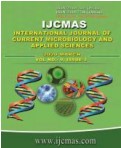


 National Academy of Agricultural Sciences (NAAS)
National Academy of Agricultural Sciences (NAAS)

|
PRINT ISSN : 2319-7692
Online ISSN : 2319-7706 Issues : 12 per year Publisher : Excellent Publishers Email : editorijcmas@gmail.com / submit@ijcmas.com Editor-in-chief: Dr.M.Prakash Index Copernicus ICV 2018: 95.39 NAAS RATING 2020: 5.38 |
Harvesting of banana bunch is a tedious work in conventional type harvesting. Various type hand tools are used for conventional type banana harvesting and it is manufactured in the local smithy shop without any design consideration, in crude manner and also with huge variations in sizes, shape and weight etc. So an human factor study was conducted on banana bunch harvesting operation with various locally available knives. In this study, various crop and tool parameters were selected. Various anthropometric data were considered as human parameters. The evaluations of conventional type knives showed that 3 mm and 6 mm thick knives were commonly available in local market. Using these available data, the cutting force required to harvest banana peduncle was measured in laboratory as well as in field with the different parameters which affect the cutting force. The ergonomic and anthropometric data were also considered for improving the knives design. The oxygen consumption rate of the subjects was measured using computerized ambulatory metabolic measurement system K4b2. The results showed that the average cutting energy of subjects varies from 1010.5 to 1282.6 Jm-2 and Average energy expenditure varies from 20.53 to 21.84 KJ min-1 during the conventional operation. Finally this study suggested a guide lines for developing new ergo refined knife. Test results proved that 3mm knives required minimum cutting energy compared to 6 mm. The material of knives also influenced the cutting force. Ergonomic study also suggested that the length and diameter of knife handle should be 150 mm and 35 mm respectively on the basis of anthropometric data available in anthropometric data book prepared by CIAE Bhopal. Weight of the knife above 400 g gave ergonomically good result.
 |
 |
 |
 |
 |